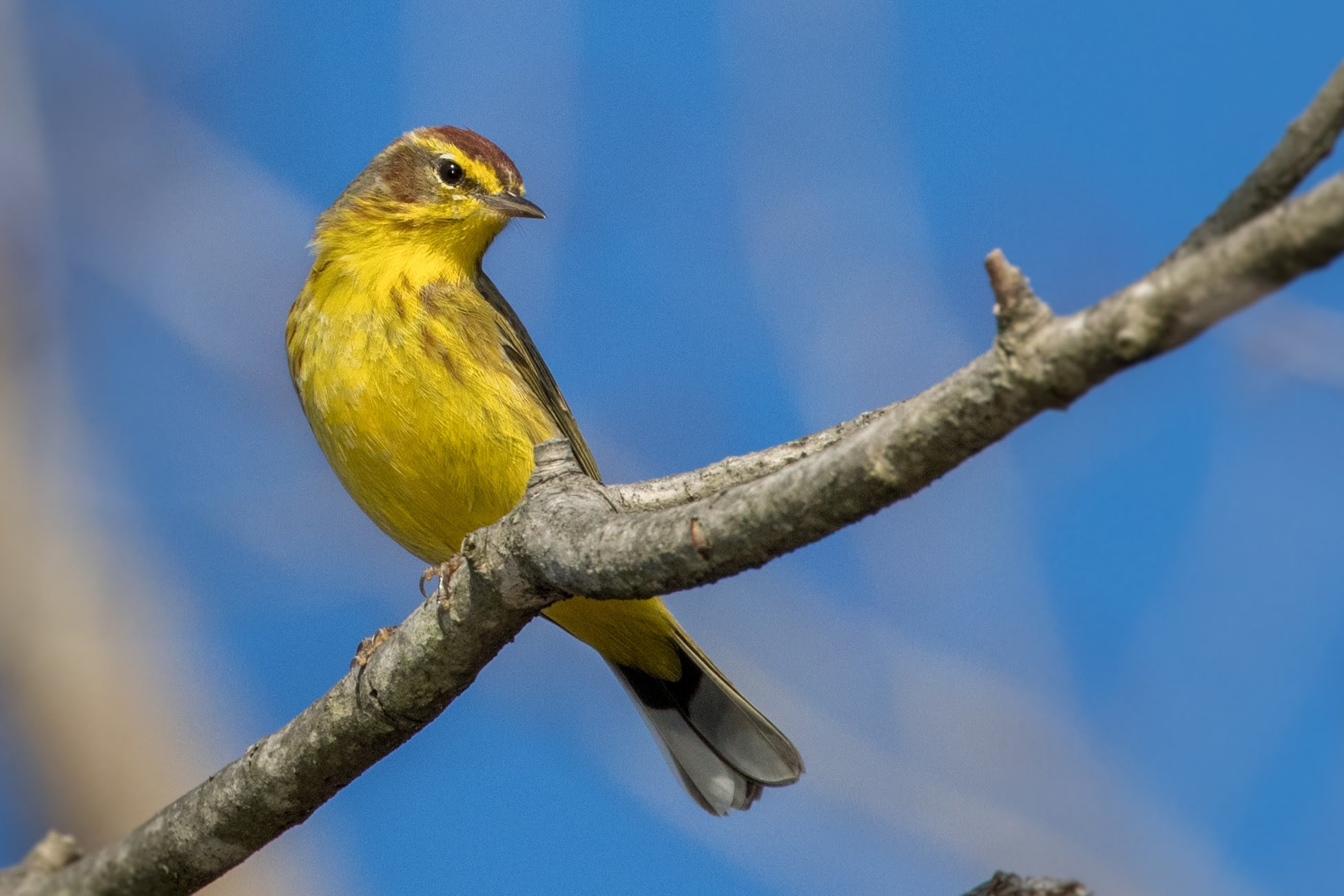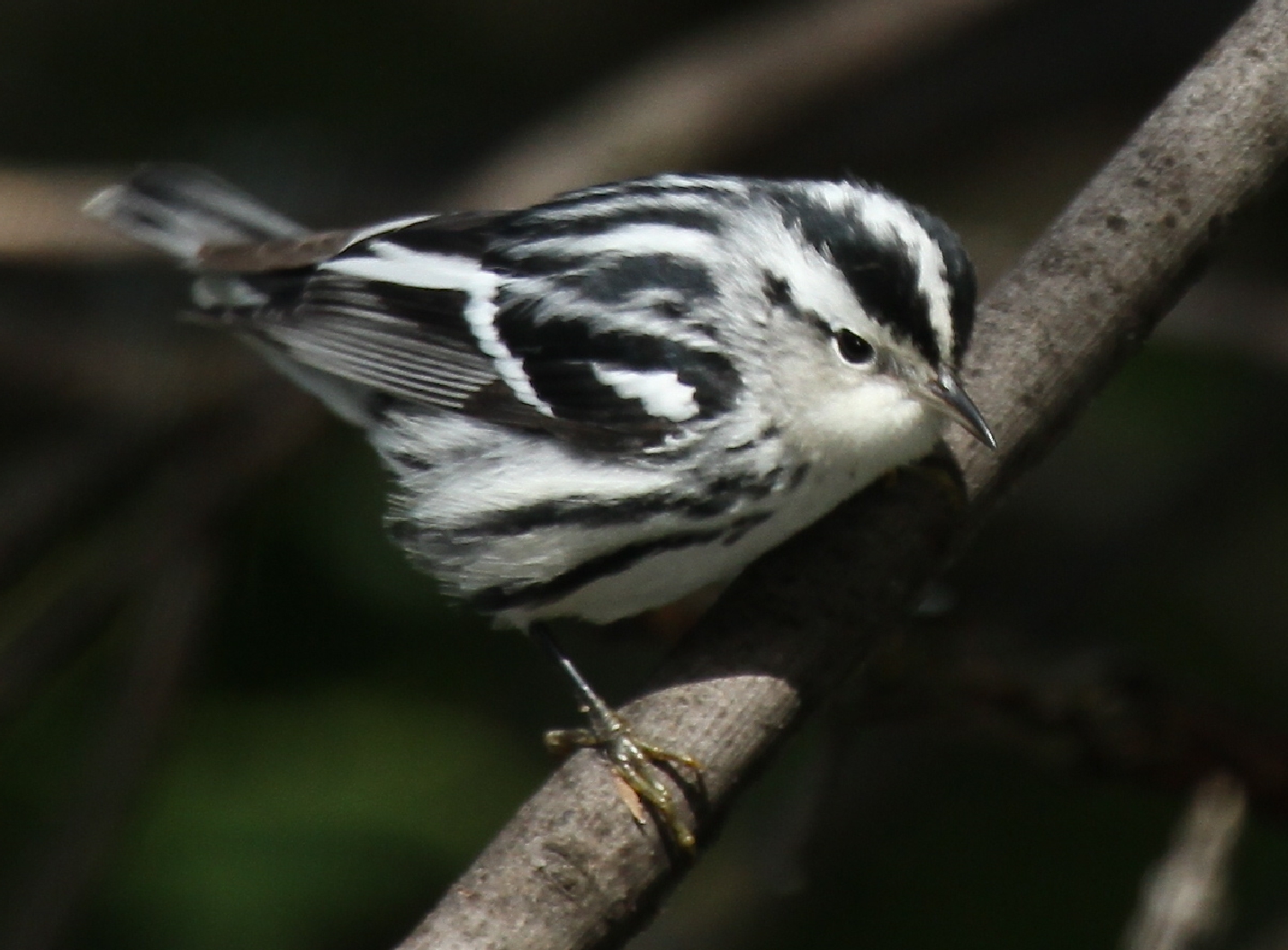|
Black-throated Grey Warbler
The black-throated gray warbler or black-throated grey warbler (''Setophaga nigrescens'') is a passerine bird of the New World warbler family Parulidae. It is long and has gray and white plumage with black markings. The male has the bold black throat of its name, and black stripes on its head, as well as black streaks on its flanks; the female is a paler version of the male, with a white throat and less distinct black markings on the flanks and wings. It breeds in western North America from British Columbia to New Mexico, and winters in Mexico and the southwestern United States. The habitats it prefers are coniferous and mixed forests and scrubland, especially those with pinyon pines, junipers, sagebrush, and oaks. Its nest is an open cup of plant fibers lined with feathers, built a few metres from the ground in the branches of a tree or shrub. Three to five eggs are laid, and young are fed by both parents. Common in its breeding range, it does not seem to be seriously threatene ... [...More Info...] [...Related Items...] OR: [Wikipedia] [Google] [Baidu] |
John Kirk Townsend
John Kirk Townsend (August 10, 1809 – February 6, 1851) was an American naturalist, ornithologist and collector. Townsend was a Quaker born in Philadelphia, the son of Charles Townsend and Priscilla Kirk. He attended Westtown School in West Chester, Pennsylvania and was trained as a physician and pharmacist. He developed an interest in natural history in general and bird collecting in particular. In 1833, he was invited by the botanist Thomas Nuttall to join him on Nathaniel Jarvis Wyeth's second expedition across the Rocky Mountains to the Pacific Ocean. Townsend collected a number of animals new to science. These included birds such as the mountain plover, Vaux's swift, chestnut-collared longspur, black-throated grey warbler, Townsend's warbler and sage thrasher, and a number of mammals such as the Douglas squirrel; several of these were described by Bachman (1839) [...More Info...] [...Related Items...] OR: [Wikipedia] [Google] [Baidu] |
Basal (phylogenetics)
In phylogenetics, basal is the direction of the ''base'' (or root) of a phylogenetic tree#Rooted tree, rooted phylogenetic tree or cladogram. The term may be more strictly applied only to nodes adjacent to the root, or more loosely applied to nodes regarded as being close to the root. Note that extant taxa that lie on branches connecting directly to the root are not more closely related to the root than any other extant taxa. While there must always be two or more equally "basal" clades sprouting from the root of every cladogram, those clades may differ widely in taxonomic rank, Phylogenetic diversity, species diversity, or both. If ''C'' is a basal clade within ''D'' that has the lowest rank of all basal clades within ''D'', ''C'' may be described as ''the'' basal taxon of that rank within ''D''. The concept of a 'key innovation' implies some degree of correlation between evolutionary innovation and cladogenesis, diversification. However, such a correlation does not make a given ca ... [...More Info...] [...Related Items...] OR: [Wikipedia] [Google] [Baidu] |
Vagrancy (biology)
Vagrancy is a phenomenon in biology whereby an individual animal (usually a bird) appears well outside its normal range (biology), range; they are known as vagrants. The term accidental is sometimes also used. There are a number of poorly understood factors which might cause an animal to become a vagrant, including internal causes such as navigatory errors (endogenous vagrancy) and external causes such as severe weather (exogenous vagrancy). Vagrancy events may lead to colonisation and eventually to speciation. Birds In the Northern Hemisphere, adult birds (possibly inexperienced younger adults) of many species are known to continue past their normal breeding range during their spring migration and end up in areas further north (such birds are termed spring overshoots). In autumn, some young birds, instead of heading to their usual wintering grounds, take "incorrect" courses and migrate through areas which are not on their normal migration path. For example, Siberian passeri ... [...More Info...] [...Related Items...] OR: [Wikipedia] [Google] [Baidu] |
Juniperus Osteosperma
''Juniperus osteosperma'' (Utah juniper; syn. ''J. utahensis'') is a shrub or small tree native to the southwestern United States. Description The plant reaches , rarely to 9 m, tall. The shoots are fairly thick compared to most junipers, in diameter. The leaves are arranged in opposite decussate pairs or whorls of three; the adult leaves are scale-like, 1–2 mm long (to 5 mm on lead shoots) and 1–1.5 mm broad. The juvenile leaves (on young seedlings only) are needle-like, long. The cones are berry-like, in diameter, blue-brown with a whitish waxy bloom, and contain a single seed (rarely two); they mature in about 18 months and are eaten by birds and small mammals. The male cones are 2–4 mm long, and shed their pollen in early spring. It is largely monoecious with both sexes on the same plant, but around 10% of plants are dioecious, producing cones of only one sex. The plants frequently bear numerous galls caused by the juniper tip midge '' Oligot ... [...More Info...] [...Related Items...] OR: [Wikipedia] [Google] [Baidu] |
Oaxaca
Oaxaca ( , also , , from nci, Huāxyacac ), officially the Free and Sovereign State of Oaxaca ( es, Estado Libre y Soberano de Oaxaca), is one of the 32 states that compose the political divisions of Mexico, Federative Entities of Mexico. It is divided into municipalities of Oaxaca, 570 municipalities, of which 418 (almost three quarters) are governed by the system of (customs and traditions) with recognized local forms of self-governance. Its capital city is Oaxaca de Juárez. Oaxaca is in southwestern Mexico. It is bordered by the states of Guerrero to the west, Puebla to the northwest, Veracruz to the north, and Chiapas to the east. To the south, Oaxaca has a significant coastline on the Pacific Ocean. The state is best known for #Indigenous peoples, its indigenous peoples and cultures. The most numerous and best known are the Zapotec peoples, Zapotecs and the Mixtecs, but there are sixteen that are officially recognized. These cultures have survived better than most others ... [...More Info...] [...Related Items...] OR: [Wikipedia] [Google] [Baidu] |
Baja California
Baja California (; 'Lower California'), officially the Free and Sovereign State of Baja California ( es, Estado Libre y Soberano de Baja California), is a state in Mexico. It is the northernmost and westernmost of the 32 federal entities of Mexico. Before becoming a state in 1952, the area was known as the North Territory of Baja California (). It has an area of (3.57% of the land mass of Mexico) and comprises the northern half of the Baja California Peninsula, north of the 28th parallel, plus oceanic Guadalupe Island. The mainland portion of the state is bordered on the west by the Pacific Ocean; on the east by Sonora, the U.S. state of Arizona, and the Gulf of California; on the north by the U.S. state of California; and on the south by Baja California Sur. The state has an estimated population of 3,769,020 as of 2020, significantly higher than the sparsely populated Baja California Sur to the south, and similar to San Diego County, California, to its north. Over 75% of ... [...More Info...] [...Related Items...] OR: [Wikipedia] [Google] [Baidu] |
Dendroica Nigrescens On Rock
''Setophaga'' is a genus of birds of the New World warbler family Parulidae. It contains at least 33 species. The males in breeding plumage are often highly colorful. The ''Setophaga'' warblers are an example of adaptive radiation with the various species using different feeding techniques and often feeding in different parts of the same tree. Most ''Setophaga'' species are long-range migrants, wintering in or near the New World tropics and seasonally migrating to breed in North America. In contrast, two ''Setophaga'' species, the palm warbler and yellow-rumped warbler, have winter ranges that extend along the Atlantic coast of North America as far north as Nova Scotia. Taxonomy The genus ''Setophaga'' was introduced by the English naturalist William Swainson in 1827. The type species was subsequently designated by Swainson in the same year as the American redstart ''Setophaga ruticilla''. The genus name is from Ancient Greek ''ses'', "moth", and ', "eating". Genetic research ... [...More Info...] [...Related Items...] OR: [Wikipedia] [Google] [Baidu] |
Flight Call
Flight calls are vocalisations made by bird Birds are a group of warm-blooded vertebrates constituting the class Aves (), characterised by feathers, toothless beaked jaws, the laying of hard-shelled eggs, a high metabolic rate, a four-chambered heart, and a strong yet lightweig ...s in flight, often serving to keep flocks together. References Bird sounds {{bird-stub ... [...More Info...] [...Related Items...] OR: [Wikipedia] [Google] [Baidu] |
Tarsus (skeleton)
In the human body, the tarsus is a cluster of seven articulating bones in each foot situated between the lower end of the tibia and the fibula of the lower leg and the metatarsus. It is made up of the midfoot (Cuboid bone, cuboid, medial, intermediate, and lateral cuneiform bone, cuneiform, and navicular) and hindfoot (Talus bone, talus and calcaneus). The tarsus articulates with the bones of the metatarsus, which in turn articulate with the proximal phalanges of the toes. The joint between the tibia and fibula above and the tarsus below is referred to as the ankle, ankle joint proper. In humans the largest bone in the tarsus is the calcaneus, which is the weight-bearing bone within the heel of the foot. Human anatomy Bones The talus bone or ankle bone is connected superiorly to the two bones of the lower leg, the tibia and fibula, to form the ankle, ankle joint or talocrural joint; inferiorly, at the subtalar joint, to the calcaneus or heel bone. Together, the talus and ... [...More Info...] [...Related Items...] OR: [Wikipedia] [Google] [Baidu] |
Blackpoll Warbler
The blackpoll warbler (''Setophaga striata'') is a New World warbler. Breeding males are mostly black and white. They have a prominent black cap, white cheeks and white wing bars. The blackpoll breeds in forests of northern North America, from Alaska throughout most of Canada, to the mountains of New York and New England. They are a common migrant through much of North America. In fall, they fly south to the Greater Antilles and the northeastern coasts of South America in a non-stop long-distance migration over open water, averaging 2500 km, one of the longest distance non-stop overwater flights ever recorded for a migratory songbird. Rare vagrants to western Europe, they are one of the more frequent transatlantic passerine wanderers. Etymology The genus name ''Setophaga'' is from Ancient Greek ''ses'', "moth", and ', "eating", and the specific ''striata'' means "striped". Description The blackpoll warbler is a fairly small bird which attains the weight of a ball point p ... [...More Info...] [...Related Items...] OR: [Wikipedia] [Google] [Baidu] |
Black-and-white Warbler
The black-and-white warbler (''Mniotilta varia'') is a species of New World warbler, and the only member of its genus, ''Mniotilta''. It breeds in northern and eastern North America and winters in Florida, Central America, and the West Indies down to Peru. This species is a very rare vagrant to western Europe. Relative to other New World warblers, it is not well studied. Description The black-and-white warbler is to in length with a mass of to grams. Wingspan ranges from 7.1-8.7 in (18-22 cm). True to their name, black-and-white warblers are black and white in colour. Both sexes have black and white crowns with a white eyebrow, black streaking on a white belly, black wings with two white wing bars, a black tail, a black-and-white streaked back, streaky undertail coverts, and grey-black legs and feet. Breeding males have a black-and-white streaked throat and black cheek, while females have a grey cheek and a white-cream coloured throat and sides. First fall males ar ... [...More Info...] [...Related Items...] OR: [Wikipedia] [Google] [Baidu] |





